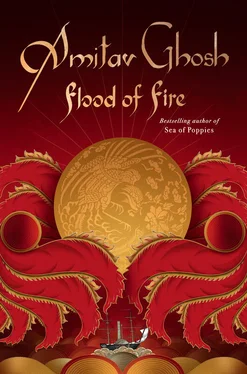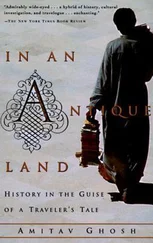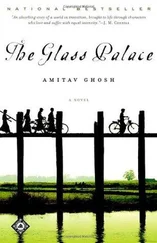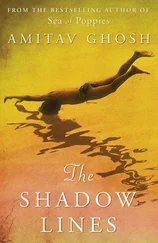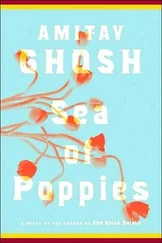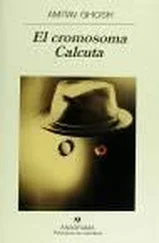This was the first time the Cambridge had undertaken a voyage of any length. Somewhat to Neel’s surprise the crew performed well together and the vessel made good time.
As they sailed downriver it became apparent to both Neel and Jodu that some kind of military action — offensive or defensive — was imminent. Extensive preparations were in progress along the river: earthworks and fortifications were being strengthened; new, camouflaged gun-emplacements had been built, and flotillas of war-junks were patrolling the channel. Twice, the Cambridge had to stop to pick up contingents of ‘water-braves’: they were travelling upriver to augment the naval force that was stationed at Humen, under the command of Admiral Guan Tiaifei (whom Neel and Compton had seen in action, in those very waters, fifteen months before).
On drawing abreast of Humen, they spotted a vessel with an American flag lying at anchor near the customs house. The flag was a decoy, Compton told Neel; the ship was actually carrying a cargo of tea for Lancelot Dent, the prominent British merchant. The transaction had been arranged by Dent’s old compradore, Peng Bao, who was now Governor-General Qishan’s translator.
That a man in as prominent a position as Peng Bao was openly colluding with an infamous opium trader like Lancelot Dent was shocking enough to Neel. But he soon learnt that this was by no means the worst of it: Compton told him that after Commissioner Lin’s removal from power many of Guangdong’s officials had gone back to their old ways and were busy feathering their own nests.
The Cambridge dropped anchor just off the tip of North Wantung Island, which was a steeply rising massif of rock, in the centre of the mile-wide channel. Here too there was a formidable fort, equipped with many heavy guns. Not far from the fort were the moorings of a new defensive barrier: a massive iron chain that ran all the way across the main shipping channel, to Humen.
Later that day Admiral Guan arrived in person to inspect the Cambridge .
Neel and the lascars watched from a respectful distance as the ship’s Chinese officers showed the admiral around: he was a distinguished-looking man in his early sixties: plainly dressed, in a dark, winter cape; on his hat was a red button. Compton explained later that this was an emblem of very high rank.
Before returning to his own junk the admiral offered a few words of encouragement to the lascars, telling them the British might attack any day and that they would earn rich rewards if they succeeded in bringing down a warship: the prize money for a seventy-four-gun frigate had now been raised to fifty thousand Spanish dollars.
Neel’s impression was of a genial, capable and highly intelligent man; this assessment was shared by Jodu who said that the admiral seemed much more knowledgeable and businesslike than the other dignitaries who had visited the Cambridge .
The next morning Neel, Jodu, Compton and a few others took a tour of the Tiger’s Mouth in a sailboat. Cruising around that wide expanse of water Neel understood how this section of the channel came by its name: narrow at both ends, the basin seemed to be bounded by powerful jaws on all sides. At one end the river flowed in as if through a gullet: here lay the area’s mightiest defences — the battlements and gun-emplacements of Humen and North Wantung. At the other end, where the river debouched into the estuary, lay two more sets of fortifications: the island of Shaitok — or Chuenpee as it was known to foreigners — was on the eastern side. Facing it across the channel was another citadel, on the headland known as Tytock.
At the end of the tour their party went ashore and walked around Chuenpee. Neel saw that there had been many changes in the fifteen months since he and Compton had last visited the island. The hamlet they had stayed in was now empty, abandoned by its inhabitants. At that time the island had been defended by two fortresses: one was on a hilltop while the other was a fortified gun-emplacement on the shore. The two had now been joined together to form a single rambling fort, enclosed by ramparts that ran all the way up the hill. These in turn were flanked by a dry moat and breastworks.
Seen from the ramparts of Chuenpee the whole of the Tiger’s Mouth looked like a vast fortified stronghold with a lake at its centre: on every eminence and promontory there were battlements and batteries. On all sides of the channel were gun-ports, hundreds of them, each marked with a colourful device: the head of a tiger.
The fortifications were impressive enough to reassure even Jodu, who had earlier voiced some doubts about the effectiveness of the defences. The British would not be able to break through, he declared confidently; not unless they destroyed every single fort.
They returned to the Cambridge in high good humour; it seemed to them that the Tiger’s Mouth was like a trap primed to close upon the British fleet.
*
Soon after the start of the English New Year the weather turned very cold and the Pearl River estuary was whipped by icy winds. On Saw Chow Island, where there was little cover, the effects were especially severe: the sepoys and camp-followers were forced into a kind of semi-hibernation; only when it was absolutely necessary did they leave their tents. Few were those who thought of anything but stuffing their stomachs and huddling under their coverings.
The sepoys were fortunate in that they had been issued greatcoats before the winter chill set in. The fifers and drummers were also lucky for they too had received woollen capes; although these were not as warm as the sepoys’ coats, they had the advantage that they could be spread out at night. Nor did the banjee-boys have any reason to complain for they were well-off compared to the camp-followers, many of whom had not received any cold-weather clothes at all. The woollens were meant to be provided by the sirdars of every group, but only the honest ones, of whom there were very few, were willing to defray the costs — and even they offered no more than a blanket or two, to be used as garments during the day and coverings at night. For the most part, the sirdars were skinflinting kanjooses who thought only of their own pockets: they gave their followers nothing more than a few moth-eaten lengths of cheap, cotton cloth — these men were left with no option but to spend their own meagre earnings on locally made quilted jackets.
But when icy blasts lashed the treeless island, even the best clothing offered little protection. Predictably, dozens of men fell ill and the field-hospital was soon filled to capacity.
Through much of the time that the weather was at its worst — the first days of January — Captain Mee was on leave in Macau. It was not till 6 January that he came back to Saw Chow, and within minutes of his return Kesri received a summons to report to his tent.
The captain offered no explanations for his absence and nor was it Kesri’s place to ask questions: they got briskly down to business.
The expedition’s high command had at last come to a decision, said the captain: an attack was to be launched on the fortifications of the Tiger’s Mouth. It would be a complex, amphibious operation involving ships, soldiers, marines and small-arms’ men from the warships.
Rolling out a chart, the captain pointed out the fortifications and gun-emplacements that encircled the Tiger’s Mouth. Their configuration was such that an attack from the seaward side would necessarily have to commence by neutralizing the two outermost forts — Chuenpee on the right bank of the channel and Tytock on the left. The operation would therefore start with simultaneous assaults on both positions: the Bengal Volunteers were to be a part of the force that would attack Chuenpee. The Enterprize would transport them to the landing-point — a beach, some two miles east of the island’s gun-emplacements.
Читать дальше
